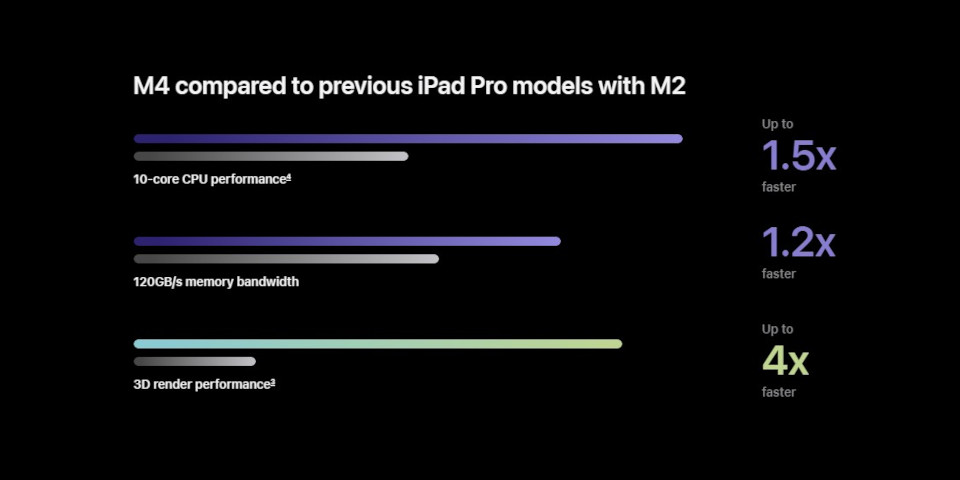Apple unveils its new M4 chip
Apple has unveiled the M4, the first chip in its fourth generation of Apple Silicon processors.
The M4, due to ship this month in the new iPad Pro, combines the hardware-accelerated ray tracing capabilities of Apple’s current M3 chips with enhanced AI capabilities.
Apple claims that the M4’s revamped Neural Engine is “more powerful than any Neural Processing Unit in any AI PC today”.
Below, we’ve summarized its key specs, and how they may affect performance of CG software.
| Entry-level Apple Silicon chips by generation | ||||
|---|---|---|---|---|
| M4 | M3 | M2 | M1 | |
| Process | 3nm | 3nm | 5nm | 5nm |
| Unified memory (1,2) | 16 GB (24 GB) |
24 GB | 24 GB | 16 GB |
| Memory bandwidth | 120 GB/s | 100 GB/s | 100 GB/s | (68Gb/s) |
| CPU cores | 10 | 8 | 8 | 8 |
| GPU cores | 10 | 10 | 10 | 8 |
| GPU compute (2) (Teraflops) |
TBC | TBC | 3.6 | (2.6) |
| Hardware-accelerated ray tracing? | Yes | Yes | No | No |
| Neural Engine cores | 16 | 16 | 16 | 16 |
| AI performance (2) (TOPS) |
38 | 18 | (16) | (11) |
| Video decode engines | 1 | 1 | 1 | 1 |
| Video encode engines | 1 | 1 | 1 | 1 |
| ProRes encode/decode engines | 1 | 1 | 1 | 0 |
| AV1 decode | Yes | Yes | No | No |
| Launch date | 2024 | 2023 | 2022 | 2020 |
(1) Maximum configuration available
(2) Figures in brackets are from third-party websites
Iterative improvements to key specs, but a big boost to AI workloads
It’s only a little over five months since Apple announced its milestone M3 family of chips, which brought hardware-accelerated ray tracing to Macs for the first time.
In comparison, the M4 feels more like an iterative update, enhancing existing capabilities rather than introducing new ones.
CPU core count rises from 8 to 10 – in Apple’s terminology, both of the new cores are ‘efficiency’ rather than ‘performance’ cores – while GPU core count and architecture remains unchanged.
Memory bandwidth also rises, from 100GB/s to 120GB/s, although the maximum RAM capacity available for an M4 chip in the new iPad Pros is only 16 GB.
That’s actually down on the M3, although that may be because the M3 is available in the much higher-powered MacBook Pro.
Like its predecessor, the M4 supports hardware-accelerated ray tracing, and its media engine supports AV1 decoding, as well as H.264, HEVC and ProRes decoding and encoding.
The main advance is in Neural Engine, the chip’s Neural Processing Unit: while core count remains unchanged, performance jumps from 18 to 38 trillion operations per second.
There are caveats to some of that, as Apple hasn’t released a lot of supporting detail on the new chip. If you’re interested, AnandTech has a detailed analysis of the M4’s architecture.
Apple’s performance comparisons between a 13-inch M4 iPad Pro and the closest equivalent M2 model. CPU performance was measured using Affinity Photo; 3D rendering with Octane X.
Benchmark comparisions for CG software
So how do those specifications translate into real-world performance in CG software?
Apple’s main specific claim is that rendering in Octane X 2024.1 is “up to 4x” faster on a 13-inch iPad Pro with a 10-core-CPU M4 than the equivalent previous-generation model, which has a 8-core-CPU M2 chip.
For CPU performance, the built-in benchmark in Affinity Photo 2.4 is “up to 1.5x faster”.
Surprisingly, Apple hasn’t quantified the impact of the M4’s Neural Engine on AI workloads.
Although an M4 iPad Pro can “isolate a subject from its background throughout a 4K video in Final Cut Pro with just a tap”, the firm doesn’t say how much faster it does so than a previous-gen M2 iPad Pro.
Price and release date
M4 chips are due to ship in the new iPad Pros, currently available to pre-order, and due in stores on 15 May 2024.
Pricing for the new iPad Pro starts at $999 for an 11-inch WiFi-only model with 256GB storage, and $1,299 for a WiFi-only 13-inch model, again with 256GB storage.
Read more about the M4 chip on Apple’s website
Have your say on this story by following CG Channel on Facebook, Instagram and X (formerly Twitter). As well as being able to comment on stories, followers of our social media accounts can see videos we don’t post on the site itself, including making-ofs for the latest VFX movies, animations, games cinematics and motion graphics projects.

